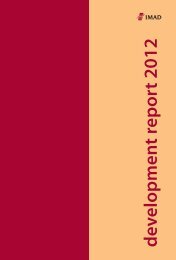Working papers published by IMAD ISSN: 1318-1920 ... - UMAR
Working papers published by IMAD ISSN: 1318-1920 ... - UMAR
Working papers published by IMAD ISSN: 1318-1920 ... - UMAR
Create successful ePaper yourself
Turn your PDF publications into a flip-book with our unique Google optimized e-Paper software.
An analysis of past and future GDP growth in Slovenia<br />
Growth in GDP and inputs in the past<br />
<strong>Working</strong> paper 3/2004<br />
<strong>IMAD</strong><br />
17<br />
to 6%. This is not particularly high in a market economy. For comparison, the EU-<br />
15 and EU-25 had average unemployment rates of 8% and 9% in 2002, respectively.<br />
Furthermore, the rise in unemployment can only explain part of the drop in<br />
employment, gross participation also fell.<br />
2.3. Human capital<br />
Another determinant of output growth is the growth in the skills of employees.<br />
Below we consider three different indicators for the average skill level of employees:<br />
i) average years of schooling; ii) average wages relative to the unskilled; and iii) a<br />
CES-composite of the skills of low- and high-skilled workers. We first consider<br />
these indicators separately, then discuss how developments in these indicators<br />
compare to each other, and end with a brief discussion of the pros and cons of one<br />
indicator compared to another.<br />
2.3.1. Average years of schooling<br />
Over the 1993-2002 period the average number of years of schooling increased<br />
from 11.0 to 11.6 years. 10 This implies an average absolute change of 0.07 years<br />
of schooling per annum, or an annual increase of 0.5 percent. For comparison,<br />
over the 1990-1998 period the average number of years of schooling in the EU-15<br />
increased from 10.0 to 10.8 years. 11 This implies an average annual absolute<br />
change of 0.1, or an annual increase of 1 percent. Hence, considering the growth<br />
in the average years of schooling Slovenia did worse than the average of the EU-<br />
15.<br />
How do we get from average years of schooling to the impact on output? For this<br />
we use the transformation of Hall and Jones (1999). The average skill index of a<br />
worker at time t, H(t), is given <strong>by</strong><br />
The increase in<br />
average years of<br />
schooling during<br />
the 1990s was<br />
lower in Slovenia<br />
than in the EU-<br />
15.<br />
H ( t)<br />
= e<br />
è<br />
θ ( s(<br />
t))<br />
,<br />
where (.) is a piece-wise linear function of the average years of schooling s(t)<br />
at time t. Motivated <strong>by</strong> micro-level studies on the returns to education Hall and<br />
Jones (1999) come to the following specification for è(.). 12 For s(t) smaller or<br />
equal to 4 years è(.) = 0.134 s(t), for s(t) in between 4 and 8 years è(.)<br />
=<br />
0.134*4 + 0.101 (s(t) - 4), and for s(t) bigger than 8 years è(.) = 0.134*4 +<br />
0.101*4 + 0.068 (s(t) - 8). Hence, although more years of schooling make an<br />
individual more productive, the returns to additional years of schooling fall with the<br />
years of schooling already accumulated. Using this transformation, we find that<br />
the average annual growth in the human capital index over the period 1993-2002<br />
was 0.4%. 13<br />
10<br />
Source: <strong>IMAD</strong>.<br />
11<br />
Source: Own calculations using data reported in Table 2.1 in OECD (2003).<br />
12<br />
See Psacharopoulos (1995) for an excellent introduction to the literature on returns to education.<br />
13<br />
Note that the growth in the average years of schooling may understate the actual growth in the human capital index when we believe<br />
that part of the skills acquired during the socialist time became obsolete during the transition, leaving a lower effective initial stock<br />
of human capital.
















